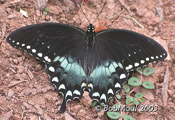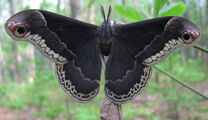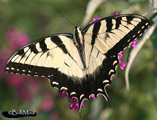Native Plants
Search for native plants by scientific name, common name or family. If you are not sure what you are looking for, try the Combination Search or our Recommended Species lists.
Lindera benzoin
Lindera benzoin (L.) Blume
Northern Spicebush, Spicebush, Wild Allspice
Lauraceae (Laurel Family)
Synonym(s):
USDA Symbol: LIBE3
USDA Native Status: L48 (N), CAN (N)
Northern Spicebush is a single- or few-stemmed, deciduous shrub, usually 6-15 ft. tall, with glossy leaves and graceful, slender, light green branches. Leaves alternate on the branchlets, up to 6 inches long and 2 1/2 inches wide, upper surface dark green, lower surface lighter in color, obovate, tapering more gradually to the base than to the tip, tip somewhat extended margins without teeth or lobes. Dense clusters of tiny, pale yellow flowers bloom before the leaves from globose buds along the twigs. Flowers occur in umbel-like clusters and are followed by glossy red fruit. Both the fruit and foliage are aromatic. Leaves turn a colorful golden-yellow in fall.
In the North this plant is thought of as the “forsythia of the wilds” because its early spring flowering gives a subtle yellow tinge to many lowland woods where it is common. A tea can be made from the aromatic leaves and twigs.
Plant Characteristics
Duration: PerennialHabit: Shrub
Leaf Retention: Deciduous
Leaf Complexity: Simple
Fruit Type: Drupe
Size Notes: Rarely up to about 20 feet tall. Usually up to about 15 feet tall.
Leaf: Green
Autumn Foliage: yes
Fruit: Red
Bloom Information
Bloom Color: White , Yellow , GreenBloom Time: Mar , Apr , May
Distribution
USA: AL , AR , CT , DC , DE , FL , GA , IA , IL , IN , KS , KY , LA , MA , MD , ME , MI , MO , MS , NC , NH , NJ , NY , OH , OK , PA , RI , SC , TN , TX , VA , VT , WVCanada: ON , PE
Native Distribution: S.w. ME, c. MI & s.e. KS, s. to FL & s.e. TX, with disjunct populations in c. TX, widely separated from those in s.e. TX
Native Habitat: Low, deciduous woods; stream banks; swamps
Growing Conditions
Water Use: MediumLight Requirement: Sun , Part Shade , Shade
Soil Moisture: Dry , Moist , Wet
CaCO3 Tolerance: Medium
Soil Description: Moist, sandy, well-drained soils. Caliche type, Limestone-based, Sandy Loam, Medium Loam
Conditions Comments: Spicebush is a fast-growing shrub, useful in moist, shady places. A small amount of sun yields a bush with better form and more berries. There are no serious disease or insect problems.
Benefit
Use Food: A tea can be made from the aromatic leaves and twigs, and the dried and powdered fruit can be used as a spice. (Niering)Conspicuous Flowers: yes
Fragrant Flowers: yes
Interesting Foliage: yes
Fragrant Foliage: yes
Attracts: Birds , Butterflies
Larval Host: Eastern Tiger Swallowtail, Spicebush Swallowtail
Butterflies and Moths of North America (BAMONA)
|
Spicebush Swallowtail (Papilio troilus)  Larval Host |
Promethea silkmoth (Callosamia promethea)  Larval Host |
Eastern Tiger Swallowtail (Papilio glaucus)  Larval Host |
Propagation
Seed Collection: Collect seeds in late summer through October when the fruit has turned red. Seeds must be cleaned before storing. Store seeds in moist sand or sow immediately. Seeds allowed to dry out lose viability.Seed Treatment: Stratify for 90-120 days at 41 degrees. Some texts say double stratification (a month of warm stratification followed by 3 months of cool stratification) is necessary.
Commercially Avail: yes
Find Seed or Plants
View propagation protocol from Native Plants Network.
Mr. Smarty Plants says
Native plant to replace invasive non-native nandina in Houston
February 28, 2010
I'm just now finding out that Nandinas are an invasive species from our local chapter of the Native Plant Society of Texas. I have three of them in my front yard and want to replace them. Can you sug...
view the full question and answer
Edible Plants for North Georgia
January 10, 2010
We are planning a forest food garden in the hollers of the N GA Mountains.
Which edible fruit, nut, berry, herb and creepers would be best for this reddish, clay-like soil? The food garden is in...
view the full question and answer
Edible Plants for a Virginia Rain Garden
October 21, 2009
Can you recommend edible plants that would be appropriate for use in a rain garden? I'm located in Charlottesville, VA, but this can be in general as well.
view the full question and answer
Evergreen shrubs for Michigan
June 17, 2008
I'm seeking a small-medium, ornamental, fairly compact, evergreen shrub to complement my front yard woodland wildflower garden. I want a shrub that will flank both sides of my front porch steps. I wa...
view the full question and answer
Evergreen native shrubs for poor drainage area in Cedar Hill, TX
March 21, 2008
Hi! I have one (big!) bed in on the front of my house. Due to the way the house/motorcourt is built, that area (when it rains as much as it did last year!) doesn't drain well. I now have to replac...
view the full question and answer
National Wetland Indicator Status
| Region: | AGCP | AK | AW | CB | EMP | GP | HI | MW | NCNE | WMVE |
| Status: | FACW | FAC | FACW | FACW | FACW |
From the National Organizations Directory
According to the species list provided by Affiliate Organizations, this plant is on display at the following locations:Lady Bird Johnson Wildflower Center - Austin, TX
Texas Discovery Gardens - Dallas, TX
Delaware Nature Society - Hockessin, DE
Texas Parks and Wildlife Department - Austin, TX
Longwood Gardens - Kennett Square, PA
Mt. Cuba Center - Hockessin, DE
Bibliography
Bibref 1186 - Field Guide to Moths of Eastern North America (2005) Covell, C.V., Jr.Bibref 1185 - Field Guide to Western Butterflies (Peterson Field Guides) (1999) Opler, P.A. and A.B. Wright
Bibref 1620 - Gardening with Native Plants of the South (Reprint Edition) (2009) Wasowski, S. with A. Wasowski
Bibref 354 - Native & Naturalized Woody Plants of Austin & the Hill Country (1981) Lynch, D.
Bibref 841 - Native Alternatives to Invasive Plants (2006) Burrell, C. C.
Bibref 291 - Texas Wildscapes: Gardening for Wildlife (1999) Damude, N. & K.C. Bender
Bibref 297 - Trees of Central Texas (1984) Vines, Robert A.
Bibref 286 - Wildflowers of the Texas Hill Country (1989) Enquist, M.
Search More Titles in Bibliography
Web Reference
Webref 38 - Flora of North America (2019) Missouri Botanical Garden, St. Louis, MO & Harvard University Herbaria, Cambridge, MA.Webref 23 - Southwest Environmental Information Network (2009) SEINet - Arizona Chapter
Webref 1 - Texas Native Shrubs (2002) Texas A&M University Agriculture Program and Leslie Finical, Dallas Arboretum
Additional resources
USDA: Find Lindera benzoin in USDA PlantsFNA: Find Lindera benzoin in the Flora of North America (if available)
Google: Search Google for Lindera benzoin
Metadata
Record Modified: 2023-04-10Research By: EJF